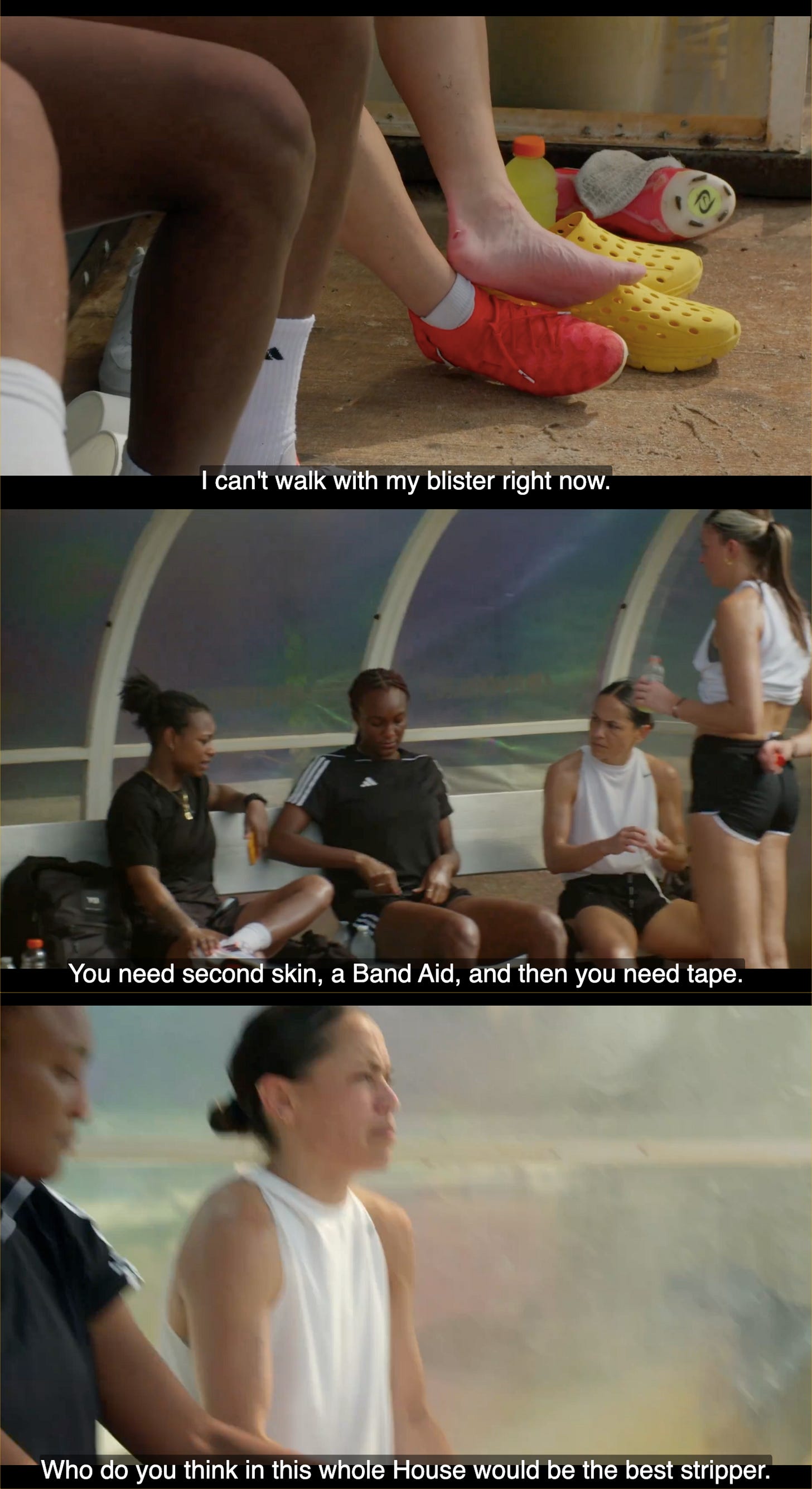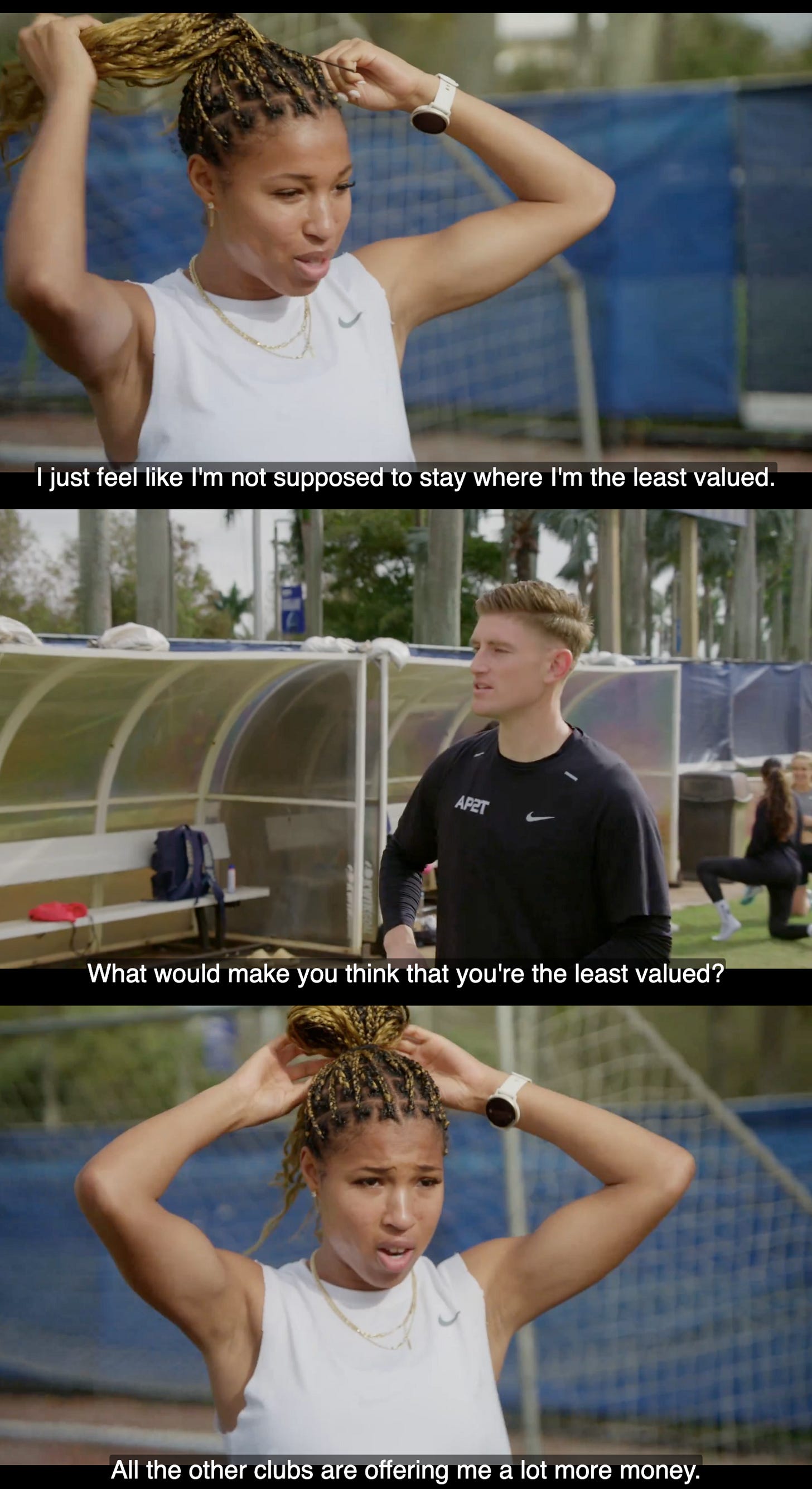The Offseason S1: E3
Thoughts on the holy trinity of women’s football topics: injuries, money and babies
Under a starry Monday evening sky, BK Häcken said goodbye to a goalkeeper legend in the women’s game as 38-year-old goalkeeper Loes Geurts played her last home game in front of the home support. After a long career traversing leagues, including an American college career, her native Netherlands and Sweden, staying true to football, she is now ready to retire. One thing she has noticed has become more difficult, that she is citing as a reason, is how it has become harder to keep the work-life balance since becoming a mother.
The same night, another mum made her return. 28-year-old Stine Larsen has been away from football for 567 days after tearing her ACL and getting pregnant shortly thereafter, and on Monday night she finally got to make her return. She was subbed on towards the end of the second half and almost scored with her first touch of the game - “it was so close, so close!” - as the tall attacker managed to get her head on a cross sailing into the box. Her daughter, now eight months old, was present in the stands to watch her mother head the ball just wide off the target.
“It’s fantastic [to have her here watching] and I feel so proud, but I’m also just so grateful to get to stand here as a mother, to see my daughter in the stands as I’ve returned from an ACL injury,” Stine said after the game.
“I would not have it any other way. Even if it has been hard, I’m so grateful for everything I have.”
On the third episode of the Offseason, the holy trinity of women’s football topics continues: injuries, money and babies.
Having talked to Geurts and Larsen after their game on Monday night, the latest Offseason episode came into my mind. None of the players on The Offseason are mothers yet, but some of them talk openly about how they would like to be, in the not too distant future. A lot of these players, although representing an age range, land somewhere in their mid-to-late 20s and early 30s. An age where thoughts on life after football start to clearly take form as injuries happen, alongside the realisations that bouncing back from them is not as easy at it might have once been. A life outside of the pitch makes itself reminded, beckoning.
For some of these players that life involves children, and they have an interesting discussion about whether they will finish their football careers before having kids. The fact that players can casually consider having children mid-football career is quite a new thing. It is in part possible thanks to the players who have walked before them. Your Jessica McDonald and Sydney Leroux and Katie Chapman and Alex Morgan and Melanie Leupolz and Emma Mitchell and Crystal Dunn and Toni Duggan. Players who have made it possible for other players to imagine their lives fuller, not stuck choosing between one thing or another.
The impact on the body is not the only obstacle waiting for athletes-turned-mums. Many working women in their 30s face the so-called “motherhood penalty,” which can influence both earnings and perceived commitment. Research by the Institute for Women’s Policy Research shows that mothers earn 29% less than non-mothers in the same roles, a penalty that disproportionately affects women as they reach seniority in their 30s.
The same research shows that the motherhood penalty is responsible for nearly 80 percent of the gender pay gap. Meanwhile, the expectation that mothers prioritise family often leads to assumptions that they are “less committed” or “less available” than their male counterparts.
Yet women continue to choose to have children.
Women, and especially younger women, are desperate to not appear “too demanding”, they do not want to be seen as gluttonous. Desiring and reaching for too much. According to a study by Glassdoor, only 32% of women in their 20s negotiate their starting salary, compared to 48% of men. The fear of being perceived as ungrateful or overly ambitious discourages many young women from advocating for fair compensation.
By their 30s, women tend to be more assertive in compensation negotiations, but the double bind still plays a role. The American Association of University Women (AAUW) found that women in their 30s who negotiate are frequently seen as “aggressive” or “uncooperative.” Consequently, these women often experience “backlash effects,” where they may be penalised with lower raises or fewer advancement opportunities due to their assertiveness.
The double bind of professionalism and femininity plays into what I like to think of as the “tax under patriarchal rule.” Women athletes are expected to perform at elite levels while appearing approachable and non-threatening, and this balancing act extends into their public personas.
As The Offseason highlights through the discussions between the athletes, women must walk a tightrope of competence and likeability, managing their weaknesses and ambitions behind a veneer of humility and teamwork. Any overt drive for personal gain or expression of vulnerability risks criticism or dismissal. This nuanced dance of respectability politics, where athletes must show strength without ego and ambition without self-interest, is an exhausting and often untenable position that detracts from the full potential of women’s sports.
Micromanagement of women
Issues around pay and injury recovery reflect the broader societal expectation that women should prioritise passion over profit, friendships over financial independence. Women athletes are often subtly (or not so subtly) discouraged from advocating for higher pay or contract stability, with the implicit expectation that their motivations should be altruistic, centered around love for the game or team camaraderie.
Money remains a sore point, as the disparities between women’s players around the world is vastly different, with only a very small number actually making larger sums of money (and most of that income coming from earnings off the pitch, according to Forbes’ list over women’s World Cup highest-paid players 2023).
A FIFPro report analysing data on national team players revealed that 29% of players did not receive any compensation from their national teams. FIFPro highlighted the significance of this statistic, noting that "these are the world’s top women’s players, on their road to the World Cup."
The report also showed that, during the 2022 Confederation Championships and the Women’s European Championships, 66% of players had to take leave—often unpaid—from other jobs to participate in these tournaments.
Let’s not even go into what it looks like when comparing it to men’s football because it’s a swamp and the amount of money being tossed around is starting to take on new levels of ridiculous.
This underinvestment not only limits women’s financial security but also impacts their access to quality training, healthcare, and post-injury support—factors critical for athletic longevity and career satisfaction.
The fact that Maria Sánchez, one of the highest paid players in the NWSL, saw participating in this reality show as one of her best options for getting some quality training in during the offseason, tells you everything about the state of the game.

The ACL injury pandemic continues to prove a significant issue in women's football, with female players being 2 to 8 times more likely to suffer these injuries than their male counterparts. Over the past 18 months, nearly 200 elite female players have sustained ACL injuries globally, with around 40 players missing the 2023 Women's World Cup due to this issue. Most of these injuries (over 60%) occur without physical contact, emphasizing the role of biomechanical and environmental factors. FIFPro has started a new venture together with PFA England, Nike and Leeds Beckett University, with the self-explaining name ‘Project ACL’. Although it’s sounding more like a mission to go out and fight the terrible ACL, they are hoping to discover more around the injury and how players can keep their ACL’s intact.
Going back to the players from Monday night, Loes Geurts and Stine Larsen — they are in very different places in their careers and albeit only 10 years apart, a gulf separates them in terms of where the game was and where it is now. Their experiences of coming through the ranks and playing will have been vastly different, so will their decision-making process, experiences and opportunities when considering becoming a mother.
Together, these stories highlight the dual roles many women athletes navigate—their identity as both dedicated professionals and mothers. Their experiences reveal the unique demands on women in sports, who often face pressures and decisions around family that can deeply impact their careers. What the show does well is bringing these stories out.
This duality also illustrates the resilience required to pursue athletic careers under circumstances that demand a choice between two powerful identities, with each player finding her own way to honor both.





